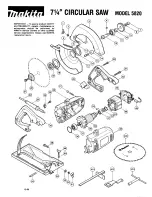
POWX1415
EN
Copyright © 2017 VARO
P a g e
|
4
www.varo.com
5.4
Power tool use and care
Do not expect the power tool to do more than it can. Use the correct power tool for what
you want to do. A power tool will achieve better results and be safer if used in the context
for which it was designed.
Do not use the power tool if the switch cannot turn it on and off. A power tool with a broken
switch is dangerous and must be repaired.
Disconnect the plug from the power source before making adjustments, changing
accessories, or storing power tools. Such preventive safety measures reduce the risk of
starting the power tool accidentally.
Store power tools, when not in use, out of the reach of children and do not allow people
who are not familiar with the power tool or these instructions to operate it. Power tools are
potentially dangerous in the hands of untrained users.
Maintain power tools. Check for misalignment or jammed moving parts, breakages or any
other feature that might affect the operation of the power tool. If it is damaged, the power
tool must be repaired. Many accidents are caused by using poorly maintained power tools.
Keep cutting tools sharp and clean. Properly maintained cutting tools with sharp cutting
edges are less likely to jam and are easier to control.
Use the power tool, accessories and cutting tools, etc., in accordance with these
instructions and in the manner intended for the particular type of power tool, taking into
account the working conditions and the work which needs to be done. Using a power tool
in ways for which it was not intended can lead to potentially hazardous situations.
5.5
Service
Your power tool should be serviced by a qualified specialist using only standard spare
parts. This will ensure that it meets the required safety standards.
6 MACHINE-SPECIFIC SAFETY WARNINGS
Hold tool by insulated grip surface when performing an operation where the cutting tool
may contact hidden wiring or its own cord. When in contact with a live wire, metallic parts
of the tool will also become live and may cause an electric shock to the operator.
Do not start the tool with the blade touching any surface. The blade action will bounce the
tool and may cause body injury.
Allow the tool to come to a complete stop before putting it down. A running tool will jerk
when the blade tip contacts any surface.
Do not cut oversized work pieces
Do not cut nails or screws unless you are using a blade specifically designed for this
purpose. Inspect your material before cutting
Before switching on the tool, be sure the blade in not contacting the work piece.
Keep hands away from moving parts and on the top surface of the work piece. Do not
place hands below work surface while saw is operating.
7 ASSEMBLY
Attention! Before performing any work on the equipment, pull the power
plug.
Always check that the power supply corresponds to the voltage on the rating name plate.
To avoid accidental start, check to make sure lock-on button is not engaged prior to plugging
in tool and you finger is not touching the ON/OFF switch trigger (3).
7.1
Install or remove the saw blade (Fig 1)
Open the chuck by rotating it in an anticlockwise direction. This will retract the pin and
allow the saw blade to be inserted.


























